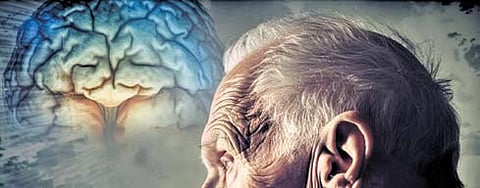Parkinson’s deep brain stimulation to regain motor control
THIRUVANANTHAPURAM : Parkinson’s disease is categorised as a diffuse degenerative brain disorder caused by dysfunction of areas responsible for motor control. Abnormal functioning of such areas in the brain leads to symptoms like tremors, rigidity of muscles and bradykinesia (slowness of movement). Genetic variations in cellular makeup often contribute to the onset of this condition as part of age-related degenerative processes.
Parkinson’s disease leads to neurotransmitter imbalances in the brain when nerve cells secreting neurotransmitters die off due to the disease. A deficiency of neurotransmitter dopamine produced by nerve cells in an area of the brain ‘substantia nigra’ is particularly important in the genesis of movement abnormalities in Parkinson’s.
A notable treatment option for Parkinson’s disease, particularly in those where the disease has somewhat advanced, is deep brain stimulation (DBS), a surgical procedure that involves implanting electrodes in precise brain areas connected to a neurostimulator resembling a pacemaker.“It addresses communication dysfunctions between nerve cells involved in movement, by emitting electrical impulses.
This stimulation modulates abnormal neural activity, offering relief from motor symptoms associated with Parkinson’s disease,” said Dr Syam Krishnan, professor of neurology, in-charge of comprehensive care centre for movement disorders, Sree Chitra Tirunal Institute for Medical Sciences and Technology, Thiruvananthapuram.“DBS has revolutionised the treatment of Parkinson’s.
However, it should be remembered that DBS is not a cure for the disease, but only a measure to control its disabling symptoms and improve quality of life. As it is not a cure and surgical implantation involves some surgical risks, inconveniences and substantial cost, it is not a first-line treatment for the disease. DBS needs to be considered only when medical treatment alone fails to give adequate symptom relief,” Dr Krishnan said.
DBS targets specific areas, such as the subthalamic nucleus (STN) or globus pallidus internus (GPi), to restore brain functions loss caused by dopamine deficiency. The procedure has shown effectiveness in improving motor function and mobility. As a viable long-term treatment for Parkinson’s, DBS provides the advantage of allowing a reduction in medication dosages, particularly levodopa, commonly used to manage symptoms.
This reduction helps minimise side effects and enhance overall quality of life.On average, DBS may improve the quality of life in patients for 5-10 years or more depending on factors like the age of the patient, profile of symptoms (which differ from patient to patient) and the duration and severity of disease at the time of implantation surgery.
Although it can notably improve tremors and muscle stiffness, its impact on balance issues and falls may be limited. DBS is typically considered for individuals with moderately advanced Parkinson’s disease whose response to oral drugs like levodopa comes down and the relief with levodopa gets limited to a short period after each dose, necessitating administration of multiple doses daily.
The decision to undergo DBS is tailored for each patient, taking into account factors such as symptom severity, overall health and individual treatment goals.“Individuals older than 70–75 years, those with substantial comorbidities and psychiatric disturbances resulting from Parkinson’s may not derive significant benefits from surgery and are usually advised to continue drug treatment.
Very advanced-stage patients who have already developed significant memory and intellectual dysfunction from Parkinson’s are also not generally considered for surgery,” says Dr Syam Krishnan.One advantage of DBS is that the neurostimulator can be programmed and adjusted externally during follow-up, enabling doctors to tackle symptoms more effectively even if they worsen.
Unlike lesioning procedures, which involve destroying specific foci in the brain to control symptoms, DBS is largely reversible and does not involve permanent damage to the brain. DBS is also done for some other movement disorders like dystonia and essential tremors and is an emerging treatment in certain types of medically refractory epilepsy as well.

